Farmhouse ale festival, now what?
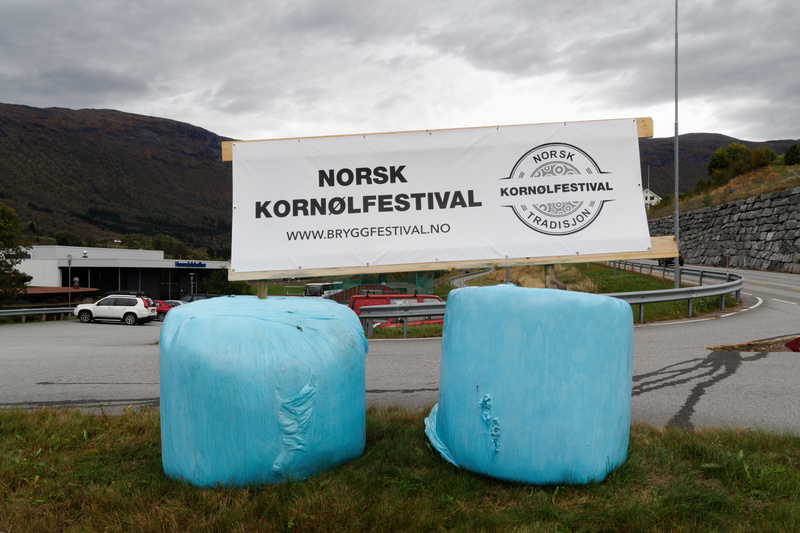
Appropriately, we use two haybales to anchor the festival sign |
Four years ago, back in 2015, William Holden told me that I was on the board for a beer festival in Hornindal to be dedicated to farmhouse ale. This was the first I heard about the festival, and the announcement that I was on the board was not preceded by asking "would you like to help arrange a festival?" or anything like that. I was just added to the group "ADMIN Kornølfestival" without further ado, and from then on treated as a member of the board.
Now, I truly hate organizing events and marketing things, so I was not at all keen on joining this board. At the same time, I could see that William was trying to do this more or less alone, so if I refused to join probably there would be no festival. What eventually persuaded me to accept was that I thought this festival could be important. At that point (2015) people were beginning to show interest in kveik and Norwegian farmhouse ale, but there was no way for them to actually taste the beer, or talk to the brewers. This festival might change that, I thought.

The view across lake Hornindal from the county centre, Grodås |
However, the idea of arranging this festival out of nothing in Hornindal made me distinctly nervous. Hornindal is a tiny place, quite far away from, well, from everything. It's not easy to get to, and the county "center" has a population of less than 500 people. There's a single hotel in the county, and the number of restaurants seems to fluctuate between 0 and 2.
If this ever made William nervous he didn't show it. He pushed ahead, found local people to help out with the organization, created logos and websites, and spread the word in every way he could think of. By sheer effort of will he convinced home brewers to sign up, commercial breweries to make the trip, and some hundreds of people to actually attend the festival. Despite my misgivings that first year was actually a success. Even though there weren't that many farmhouse brewers present, there were just enough of them to make the festival work.
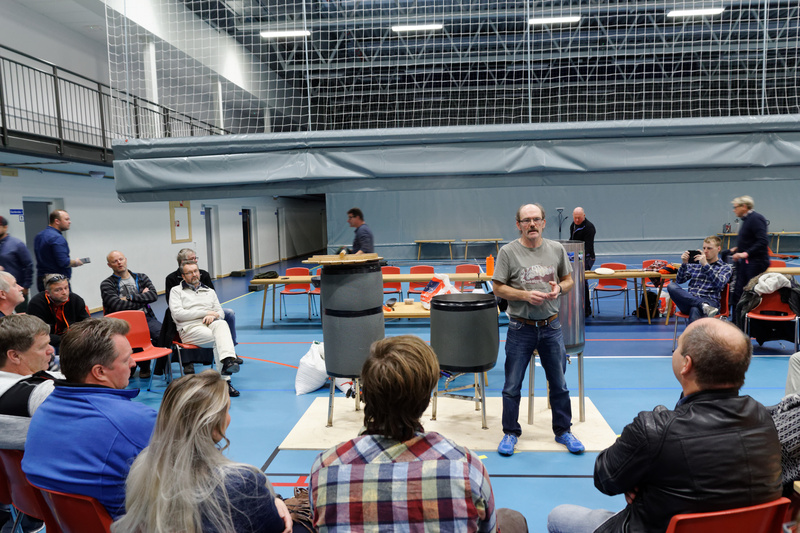
Lars Andreas Tomasgård (owner of kveik #21) demonstrating raw ale brewing with kveik in the festival hall |
From there we were able to expand the event. The next two years we invited Simonas Gutautas (with friends) from Lithuania to demonstrate brewing of true traditional stone beer (2017), then keptinis (2018). Showing baking of the mash in the oven was, if I may say so myself, a quite spectacular sight. We also flew in Richard Preiss to talk about his kveik research, and Martyn Cornell to write about the festival.

Ričardas Počius retrieving the baked mash from the oven |
Last year we had the best-attended festival ever, and things seemed to be going swimmingly. Except for one thing. Most of the organization was being done by William, because while the rest of us had day jobs, his heart condition made it impossible for him to a have a normal full-time job. William was the kind of person who can't sit still, so he dedicated himself to running the festival. He had a high-risk heart operation in 2017 that worked out very well, but then he got cancer. A few weeks after last year's festival, he died. On top of the personal shock of losing someone we'd worked so closely with for several years the remaining board members now had to decide: where do we go from here?
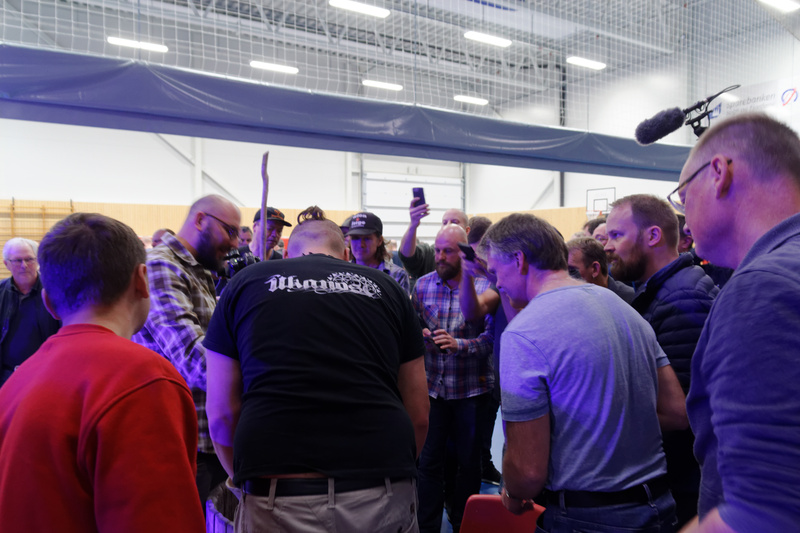
Ričardas and Simonas mobbed by the crowd when lautering the baked mash |
I expected the board to have a long discussion over whether we should arrange a festival in 2019, but to my surprise everyone took it for granted that we would. Instead, discussion turned to who should take over as chairman after William. To my dismay I quickly found that the board thought I should take the job. As I've said before, I don't enjoy this kind of job, and I have more than enough to do with my day job, ongoing research, and giving talks/writing articles.
So why did I say yes? Well, the board is not very large, and none of us get any pay at all. Some of us have some of our costs covered, but that's it. And nobody else seemed to feel they could take it on. So once again there didn't seem to be any viable alternative if the festival was to live on. And by now the festival really was becoming very important.
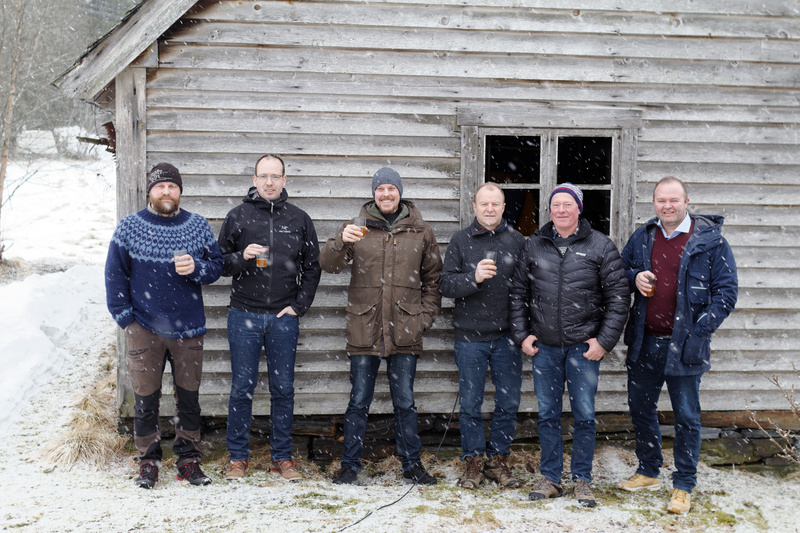
The board at the 2019 annual meeting in Voss. Left to right: Roar Sandodden, yours truly, Amund Polden Arnesen, Ståle Raftevold, Stig Jarle Seljeset, Gard Mek. Missing was Eirik Hoem. |
For me a key point in spreading the word about farmhouse ale has been to convince people in the brewing regions that their brewing tradition is something to be proud of. The festival has really done that, by showing them that people travel literally from all over the world just to experience the local brewing tradition. Endorsement from the New York Times made people quite excited, too. The festival, and this kind of news about it, generates media coverage in western Norway, and really creates a buzz around the local brewing that I think helps encourage the brewers and others to keep the tradition alive.
And at the end of the day keeping the tradition is alive is what this is all about. It's really only people in western Norway who can do that. But they're only going to do it if they see it as worthwhile and important. International attention seems to be one of the best ways to achieve that.
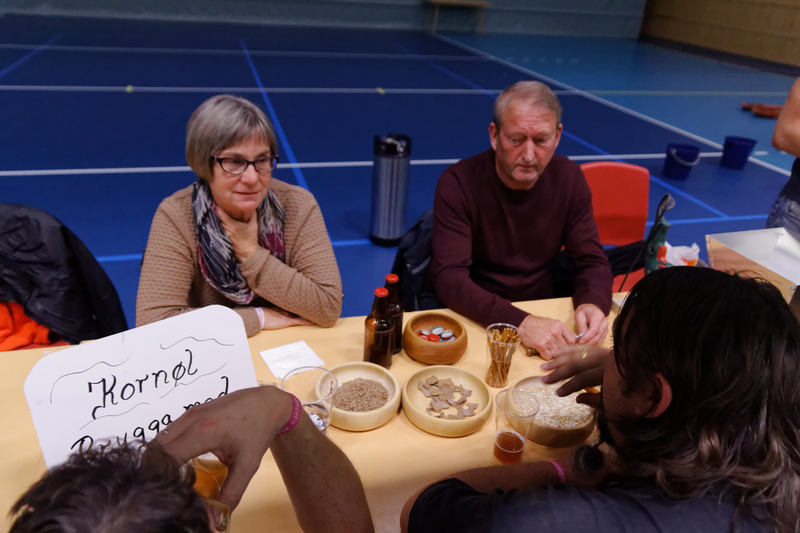
Arve Espe and wife (owners of kveik #20) being quizzed. Note the dried kveik on the table. |
The festival has turned out to have another function as well: it's pretty much the only way for outsiders to taste these beers, to participate in a brewing session, and to actually meet the brewers. And you can't really understand farmhouse ale if you've never tasted it. It's also important for the Norwegian commercial brewers who want to play with kveik and traditional methods, because here they can learn first-hand how to approach it. A good example is Nøgne Ø. Their brewer, Edvard Hortemo, came to the festival, tasted the beers, and talked with the brewers, then went home and brewed the first commercial Norwegian raw ale where the raw ale flavours really worked: Nøgne Ø Raw. He was able to do that because he'd tasted the original farmhouse beers and knew what to aim for.
So this festival has become a very important thing, and we basically have no choice but to keep it going. And let me be clear that while the rest of the board (me included) have contributed to the festival, I'd say 90% of the credit goes to William. And now we have to try to bring it off without him. We're well on our way to doing that, but clearly it won't be the same without him.
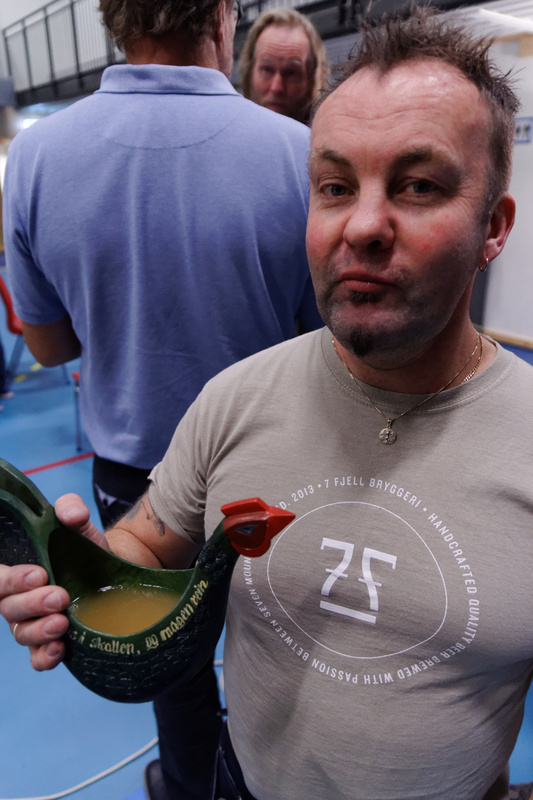
William Holden drinking from an ølhøne ("beer hen") at the 2016 festival |
If you want to go, see the festival site here, or the Facebook event.
Similar posts
Farmhouse ale festival 2016
Last year the first ever festival wholly dedicated to farmhouse ale (I think), Norsk Kornølfestival 2016, was held in Hornindal in western Norway
Read | 2017-08-12 14:21
Roaring the beer
The first time I heard about it was in Telemark (southern Norway), where Halvor Nordal said that one of his neighbours used to sometimes heat the beer very briefly in a saucepan before serving it
Read | 2018-04-21 22:45
Me, a beer judge?
To my surprise, Geir Ove asked me whether I wanted to be one of the judges for the annual Norwegian Christmas Beer Homebrewing contest
Read | 2007-12-04 19:50
Comments
Johann Renner - 2019-06-16 14:27:14
Thank you Lars and to all the board members for keeping this celebration alive. Even if to me it is very difficult to assist (I'm from Chile, South America), I love reading about kveik and farmhouse brewing, the traditions are very inspiring to my own brewing. I wish you a very successful Kornølfestival!
Martyn Cornell - 2019-06-16 20:39:36
The warm glow from knowing you’re doing one of the most important jobs in beer right now probably doesn’t make up for all the hard work and stress, but probably tens of thousands, if not more, beer drinkers are hugely grateful for what William started and you and the others are continuing.
Nick Trausch - 2020-05-02 13:17:41
Thanks Lars for the great brewing blog. A friend in our local homebrew club and I are planning a farmhouse ale either together or separately in the near future. We both have the ingredients and the Voss Kviek. Both of us enjoy your blog. We live in eastern Ohio in the US. Our club (HOOCH) - Homebrewers Of the Ohio valley Club House, did a sahti a few years ago and it was a great experiment. Best of luck with your festival.